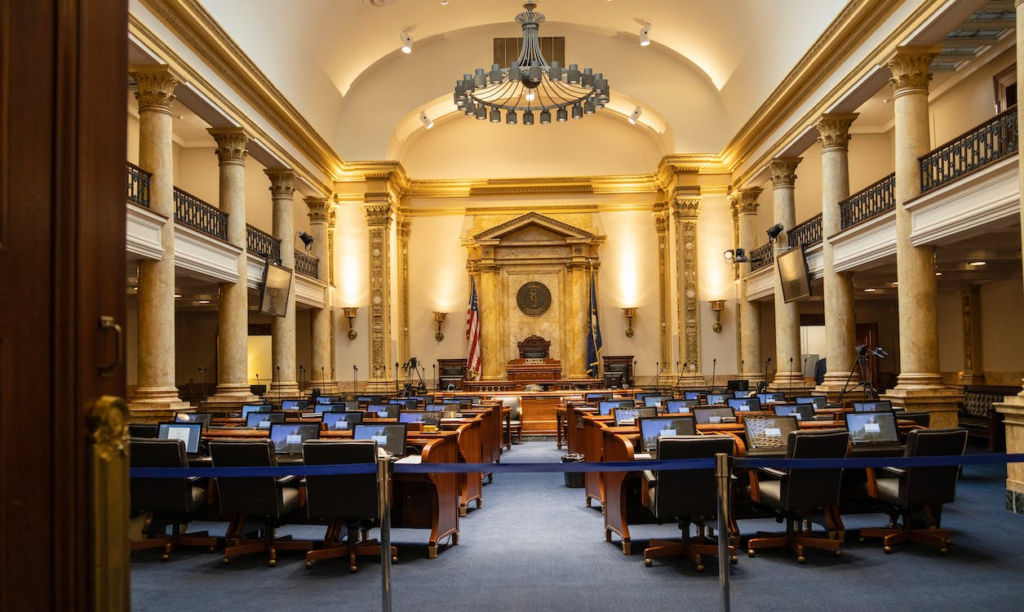In the aftermath of the Revolutionary War, the newly independent states of America found themselves under a governance structure defined by the Articles of Confederation. This initial governing document was framed during a time of war, intending to preserve the independence and sovereignty of the states. However, it soon became apparent that this loosely tied confederation was inadequate for the challenges of a growing nation. Economic instability, interstate conflicts, and the inability of the central government to raise revenue or maintain public order were glaring issues.
One notable manifestation of discontent was Shays’ Rebellion (1786-1787), a series of protests by American farmers against state and local enforcement of tax collections and judgments for debt. The rebellion spotlighted the inability of the Articles to provide for a strong federal government capable of addressing such internal disturbances.
The inadequacies of the Articles spurred the convening of the Constitutional Convention in 1787, held in Philadelphia. Esteemed figures of American history, including George Washington, James Madison, and Benjamin Franklin, were among the 55 delegates tasked with amending the Articles. However, the convention quickly morphed into a much more ambitious endeavor aimed at crafting a new constitution.
The delegates engaged in fervent debates and negotiations, tackling a multitude of issues. Among the critical compromises reached were the Great Compromise, which balanced representation in Congress between large and small states, and the Three-Fifths Compromise, which addressed the contentious issue of slavery in representation. On September 17, 1787, the U.S. Constitution was signed, encapsulating a vision of a stronger federal government, yet still reserving significant powers to the states.
Importance and Relevance of the U.S. Constitution in Modern Society
The U.S. Constitution remains a pivotal document, laying the foundations for the federal government and delineating its powers and limitations. It introduced a novel system of government characterized by a separation of powers among three co-equal branches—the Legislative, Executive, and Judicial—each with a system of checks and balances to prevent any single entity from gaining absolute power.
Moreover, the Constitution serves as the bedrock of the rule of law, providing a stable legal framework that governs the land. It’s a living document that has been amended 27 times, reflecting the evolving values and principles of the nation. The Bill of Rights, the first ten amendments to the Constitution, and subsequent amendments have continuously served to uphold and extend civil liberties and rights, demonstrating the enduring importance of the Constitution in safeguarding individual freedoms and promoting social justice.
The U.S. Constitution’s relevance extends beyond its historical significance; it continues to guide legal interpretations, political debates and societal norms. As we delve deeper into this remarkable document in the following sections, we will explore its content, evolution and the profound impact it has had on American society and the global discourse on governance and human rights.
The Preamble

The Preamble to the U.S. Constitution is a brief introductory statement that outlines the broad objectives and the guiding principles of the document. It reads:
“We the People of the United States, in Order to form a more perfect Union, establish Justice, insure domestic Tranquility, provide for the common defence, promote the general Welfare, and secure the Blessings of Liberty to ourselves and our Posterity, do ordain and establish this Constitution for the United States of America.”
The phrase “We the People” reflects a foundational idea of American democracy: sovereignty resides in the people. It was a bold assertion that governance should derive its legitimacy from the consent of the governed, rather than from a monarchy or a select elite. This notion was revolutionary at the time and underscored a shift towards a more inclusive and participatory form of governance.
The objectives set forth in the Preamble are far-reaching. “Forming a more perfect Union” acknowledged the inadequacies of the previous government under the Articles of Confederation and aimed at creating a stronger, more unified national structure. “Establishing Justice” and “insuring domestic Tranquility” emphasized the importance of a fair legal system and a peaceful societal order. “Providing for the common defence” highlighted the government’s duty to protect its citizens from external threats, while “promoting the general Welfare” encapsulated a broader aim of fostering a prosperous and healthy society. Lastly, “securing the Blessings of Liberty” expressed a desire to protect individual freedoms for “ourselves and our Posterity”, underlining a hope for enduring liberty for future generations.
Significance of the Preamble in Stating the Constitution’s Objectives
The Preamble, though not legally binding, plays a crucial role in understanding the ethos and the objectives of the Constitution. It sets the stage for the detailed framework that follows in the Articles and the Amendments. It has also played a role in judicial interpretation, where judges and legal scholars often reference it to elucidate the broader goals of the Constitution when adjudicating cases or interpreting constitutional provisions.
Moreover, the Preamble serves as a historical document reflecting the ambitious vision of the nation’s founders. It encapsulates a forward-looking, aspirational mindset that has, over centuries, guided the evolution of American democracy. Through its succinct but powerful language, the Preamble continues to resonate with the American populace and remains a potent symbol of the nation’s democratic ideals and its enduring commitment to achieving a more perfect union.
The Articles of the Constitution

Legislative Branch (Article I)
Article I establishes the structure and powers of the U.S. Congress, the bicameral legislature comprising the Senate and the House of Representatives. It delineates the qualifications for membership, terms of office and the procedures for legislative action. Key powers granted to Congress include the authority to levy taxes, regulate commerce, declare war and maintain armed forces. This article also introduces the necessary and proper clause, allowing Congress to make laws essential for executing its enumerated powers.
Executive Branch (Article II)
Article II outlines the framework for the executive branch, headed by the President. It specifies the qualifications for the presidency, the method of election and the powers and duties of the office. The president’s responsibilities include serving as the commander-in-chief of the armed forces, making treaties, appointing federal officials and ensuring the faithful execution of the laws.
Judicial Branch (Article III)
Article III establishes the U.S. Supreme Court and permits Congress to create lower federal courts. It defines the jurisdiction of the federal judiciary, including cases arising under the Constitution, federal laws, treaties and controversies between states or between a state and foreign entities. This article also addresses treason, providing a narrow definition to safeguard civil liberties.
States’ Powers and Limits (Article IV)
Article IV discusses the powers and limits of states, emphasizing the principle of federalism. It mandates full faith and credit for each state’s public acts, records, and judicial proceedings and ensures a republican form of government for every state. It also provides for the admission of new states and the management of federal territories.
Amendments to the Constitution (Article V)
Article V outlines the process for amending the Constitution, allowing for its evolution over time. It provides two methods of proposing amendments—by Congress or a constitutional convention—and two methods of ratification—by state legislatures or state conventions.
Federal Power (Article VI)
Article VI declares the Constitution, federal laws and treaties as the supreme law of the land. It mandates an oath of office for all government officials and provides for the repayment of the national debt. This article also contains the supremacy clause, affirming the federal government’s authority over states in constitutional matters.
Ratification (Article VII)
Article VII details the process for the Constitution’s ratification. It required the approval of nine states for the Constitution to become effective. The prompt ratification process led to the establishment of the new federal government on March 4, 1789.
The Structure of Federal Government as Outlined in the Articles
The Articles collectively set the groundwork for a federal system of government, where power is divided between a central authority and constituent political units (states). They create a framework of checks and balances, ensuring that no single branch of government becomes too powerful. Through these Articles, the Constitution innovatively addresses the challenges faced by the young nation, laying a strong foundation for governance and rule of law and paving the way for the United States’ growth and development over the centuries.
The Bill of Rights

The Bill of Rights, comprising the first ten amendments to the U.S. Constitution, was ratified on December 15, 1791. This crucial addition was a response to calls from several states for greater constitutional protection for individual liberties. The Bill of Rights addresses a range of fundamental rights and principles, encapsulating the values of freedom, equality and justice.
- First Amendment: Protects the freedoms of speech, religion, press, assembly and the right to petition the government.
- Second Amendment: Safeguards the right to keep and bear arms.
- Third Amendment: Prohibits the quartering of soldiers in private homes without the owner’s consent.
- Fourth Amendment: Protects against unreasonable searches and seizures, requiring a warrant for such actions.
- Fifth Amendment: Outlines various legal protections for individuals, including the right to due process and protection against double jeopardy and self-incrimination.
- Sixth Amendment: Ensures the right to a fair trial, including the right to a speedy trial, an impartial jury and legal counsel.
- Seventh Amendment: Guarantees the right to a jury trial in certain civil cases.
- Eighth Amendment: Prohibits excessive bail, fines and cruel and unusual punishment.
- Ninth Amendment: States that the enumeration of certain rights in the Constitution does not deny or disparage other rights retained by the people.
- Tenth Amendment: Reserves powers not delegated to the federal government to the states or the people.
Historical Context and the Importance of the Bill of Rights in Protecting Individual Freedoms
The drafting and ratification of the Bill of Rights were largely driven by the Anti-Federalists, who feared that the new Constitution vested too much power in the federal government and lacked adequate safeguards for individual rights. Their advocacy, alongside public discourse, led to the adoption of the Bill of Rights, significantly impacting the nation’s legal and cultural landscape.
The Bill of Rights has since played a vital role in protecting individual freedoms from government encroachment. Over time, judicial interpretations of these amendments have shaped the nation’s laws and societal norms, particularly in areas such as free speech, religious freedom and criminal justice. The rights enshrined in this document have become foundational to the American identity, showcasing a profound commitment to individual liberty and justice. Through court rulings and public discourse, the Bill of Rights continues to influence American society, serving as a bulwark against tyranny and a beacon of democratic values.
Subsequent Amendments

Following the Bill of Rights, the U.S. Constitution has been further amended 17 times, reflecting the evolving societal values, addressing emerging issues and rectifying previous oversights. Some of these amendments have had a profound impact on the American governance structure and societal norms. Here are a few notable amendments post-Bill of Rights:
- Thirteenth Amendment (1865): Abolished slavery and involuntary servitude, except as punishment for a crime.
- Fourteenth Amendment (1868): Granted citizenship to all persons born or naturalized in the U.S., including former slaves and provided equal protection under the law.
- Fifteenth Amendment (1870): Prohibited the denial of the right to vote based on race, color, or previous condition of servitude.
- Nineteenth Amendment (1920): Extended the right to vote to women.
- Twenty-Sixth Amendment (1971): Lowered the voting age from 21 to 18, reflecting the broader societal recognition of young adults’ rights and capabilities.
Impact of these Amendments on American Society and Governance
The subsequent amendments to the Constitution have significantly shaped American society and governance, bringing about more inclusivity and equality. For instance, the Thirteenth, Fourteenth, and Fifteenth Amendments, known collectively as the Reconstruction Amendments, were crucial in the effort to rebuild the nation post-Civil War and establish civil rights for newly freed slaves.
The Nineteenth Amendment marked a significant milestone in the women’s suffrage movement, aligning the Constitution with evolving societal norms regarding gender equality. Similarly, the Twenty-Sixth Amendment recognized the changing status of young adults in society, particularly in the context of the Vietnam War era where many young people were drafted into military service yet were unable to vote.
These amendments demonstrate the Constitution’s capacity to evolve and adapt, reflecting the changing values and needs of the American populace. Through these amendments, the Constitution has become a more inclusive document, continually striving to uphold the principles of justice, equality and freedom in a changing world. The process of amending the Constitution also underscores the dynamic interaction between the populace, the legislature and the broader societal discourse in shaping the nation’s fundamental law.
The Constitution as a Living Document

The U.S. Constitution has often been referred to as a “living document,” signifying its capacity to evolve and adapt to changing societal norms and circumstances. The Constitution’s language, while precise, often embodies broad principles that require interpretation. Over the centuries, varying interpretations have emerged, often reflecting the political and social dynamics of different eras.
- Judicial Review: The practice of judicial review, established in Marbury v. Madison (1803), empowers the judiciary to interpret the Constitution and evaluate the constitutionality of legislative and executive actions.
- Constitutional Interpretation: Various schools of thought, such as Originalism and Living Constitutionalism, have emerged, reflecting differing approaches to constitutional interpretation. While originalists seek to interpret the Constitution as its framers intended, proponents of living constitutionalism argue for a more dynamic interpretation, adapting the document to contemporary societal needs.
- Precedent and Stare Decisis: Legal precedents set by judicial interpretations play a significant role in shaping constitutional understanding and application. The principle of stare decisis – letting the decision stand – underscores the legal system’s adherence to precedent, promoting stability and predictability.
Numerous Supreme Court cases have had a profound impact on constitutional interpretation, often shaping national policy and societal norms.
- Brown v. Board of Education (1954): Overturned the separate-but-equal doctrine, marking a significant stride towards racial equality.
- Roe v. Wade (1973): Established a woman’s legal right to an abortion under the constitutional right to privacy.
- Obergefell v. Hodges (2015): Extended the right to marry to same-sex couples, showcasing the Constitution’s role in advancing social justice and equality.
These cases, among many others, highlight the evolving nature of constitutional interpretation and its impact on American society. Through judicial review, the Supreme Court continues to play a critical role in navigating the complex interplay between the Constitution, legislative intent, and societal values, ensuring the enduring relevance and adaptability of this foundational document.
Criticisms and Controversies
Despite its enduring significance and foundational role, the U.S. Constitution has been the subject of various criticisms and debates. Some of the perceived shortcomings include:
- Original Sin of Slavery: The Constitution’s original accommodation of slavery, notably through the Three-Fifths Compromise, is often seen as a grave moral failing.
- Gender and Racial Exclusions: Initially, the Constitution did not provide voting rights or equal protection under the law for women and minority groups, which required rectification through subsequent amendments.
- Electoral College: Critics argue that the Electoral College, established by the Constitution to elect the president, is outdated and can result in a president being elected without a popular majority.
- Difficulty in Amending: The high threshold for amending the Constitution is seen by some as a barrier to necessary reforms and adaptations.
Several debates and proposed amendments reflect ongoing concerns and the dynamic dialogue surrounding the Constitution:
- Equal Rights Amendment (ERA): The ERA, which seeks to guarantee equal legal rights regardless of sex, has been a topic of discussion for decades, reflecting broader societal debates on gender equality.
- Campaign Finance Reform: In the wake of decisions like Citizens United v. FEC, there’s been a push for constitutional amendments to address campaign finance issues.
- Voting Rights: Ongoing debates around voting rights, voter ID laws and gerrymandering reflect a continuing struggle to achieve fair representation and electoral integrity.
The array of criticisms, debates and proposed amendments underscore the Constitution’s central role in American political and social discourse. They reflect a broader societal engagement with the principles enshrined in the Constitution and a continual striving to better align the document with evolving understandings of justice, equality and democratic governance. The vibrant discourse surrounding the Constitution also highlights the document’s living nature and its capacity to provoke thought, discussion and action aimed at refining the nation’s governing framework and advancing its foundational ideals.
Conclusion
The U.S. Constitution remains a remarkable document that has stood the test of time, guiding the nation through various epochs of change, challenges and advancements. Its genius lies in its simplicity, flexibility, and the broad principles it encapsulates, allowing for an evolving interpretation that reflects the nation’s changing values and circumstances. From its preamble to its amendments, the Constitution provides a robust framework for governance, safeguards individual liberties, and embodies the nation’s aspirations towards justice, equality and freedom.
As we have navigated through the intricate layers of the U.S. Constitution, it’s evident that this document is not just a static set of rules, but a living dialogue between the past, present and future. It invites ongoing exploration, interpretation, and engagement, not only by legal scholars and political leaders but by every citizen. Understanding the Constitution, its history and its implications is crucial for informed civic participation and for the continual endeavor to form a more perfect union.
The journey doesn’t end here. The U.S. Constitution is a wellspring of insight into the American identity and the democratic ideals that continue to influence the global discourse on governance and human rights. As readers, delving deeper into the Constitution, engaging with its text, its interpretations, and its critiques, can foster a richer understanding of the nation’s legal and cultural fabric and inspire a more informed and active citizenship.
With the Constitution as our guide, we can continue to explore, debate, and shape the evolving narrative of American democracy, striving towards a more just, equitable and free society. The U.S. Constitution stands as a testament to the enduring power of well-crafted words, the foresight of the Founding Fathers and the ongoing endeavor to ensure that the principles it enshrines are actualized in the lived experiences of all citizens.
Further Reading
Engaging with a variety of resources can provide a more nuanced understanding of the U.S. Constitution. Below are some recommended readings and resources for those looking to delve deeper into the topics discussed in this article:
Books
- “The Federalist Papers” by Alexander Hamilton, James Madison, and John Jay: A collection of essays written in favor of the Constitution’s ratification, providing insight into the framers’ intent.
- “America’s Constitution: A Biography” by Akhil Reed Amar: An exploration of the Constitution, its history and its impact on American society.
- “The Bill of Rights: Creation and Reconstruction” by Akhil Reed Amar: A look at the creation of the Bill of Rights and its interpretation throughout history.
Online Resources
- The National Archives: Provides access to the U.S. Constitution, the Bill of Rights, and other founding documents, along with historical context and educational resources.
- The Library of Congress: Offers a wide range of resources on the U.S. Constitution, including historical documents, legal analysis and educational materials.
- Constitution Annotated: An online resource providing a clause-by-clause interpretation of the U.S. Constitution, along with Supreme Court cases relevant to each clause.

